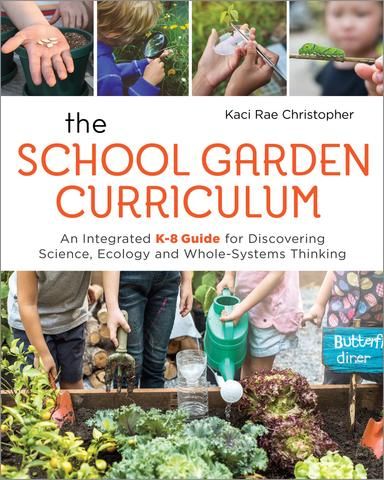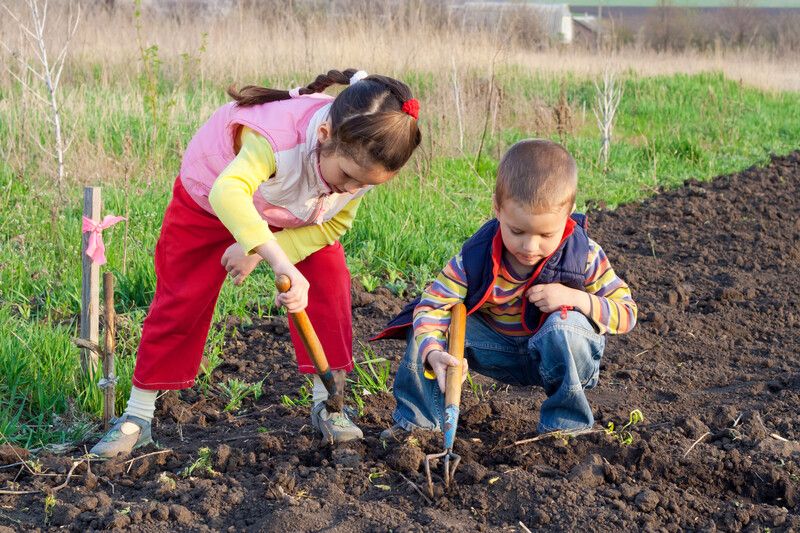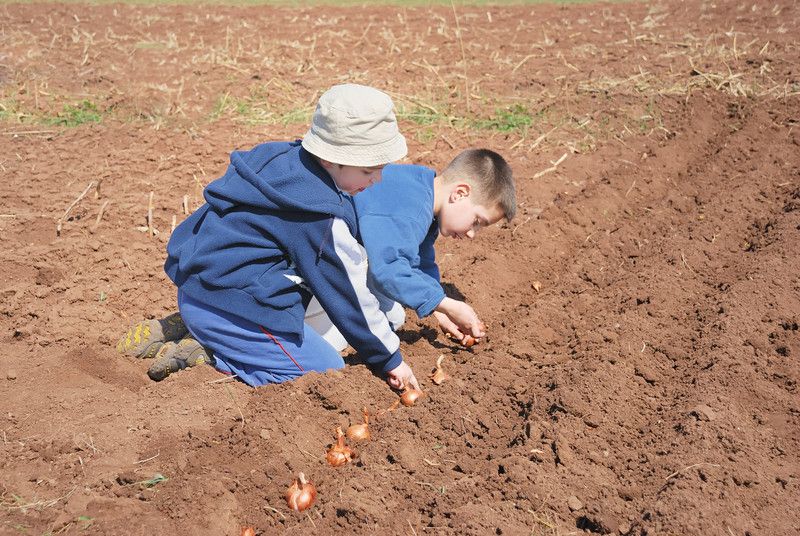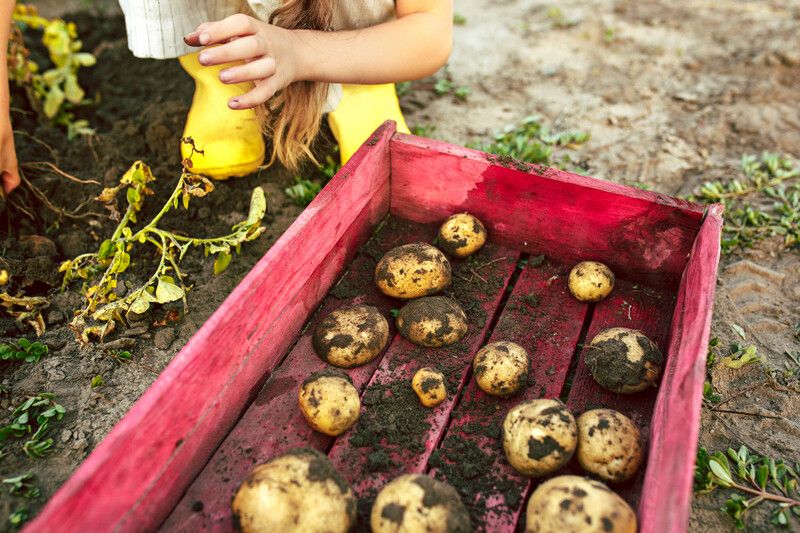This article was previously published in Canadian Teacher Magazine’s Spring 2019 issue.
This article was adapted from the Introduction to The School Garden Curriculum: An Integrated K – 8 Guide for Discovering Science, Ecology, and Whole-Systems Thinking, published by New Society Publishers in 2019 (a version first appeared in Canadian Teacher Magazine’s Spring 2019 issue). Although this book was written to provide guidance in developing school gardens, it is essentially about the value of children’s gardens, which can be established by parents and children at home, which will address many goals of the Science curriculum.
 In an age when many children are becoming disconnected from nature, farmland is being saturated with chemicals, the global climate is unpredictable and extreme, and wild habitats are being replaced by urban development, our communities need creative and innovative leaders to change our world. We need children to learn and engage in a new land ethic that inspires Care for Self, Care for Others, and Care for the Land; we need new generations of changemakers and environmentally conscious global citizens.
In an age when many children are becoming disconnected from nature, farmland is being saturated with chemicals, the global climate is unpredictable and extreme, and wild habitats are being replaced by urban development, our communities need creative and innovative leaders to change our world. We need children to learn and engage in a new land ethic that inspires Care for Self, Care for Others, and Care for the Land; we need new generations of changemakers and environmentally conscious global citizens.
 We accomplish this by encouraging children to engage in ecosystems and by creating spaces for cooperative stewardship and interaction. We provide opportunities to practise building community, creative problem-solving, healthy lifestyles, personal responsibility, craftsmanship, and engagement in nature through science. Gardens are a powerful place to learn these valuable skills and to foster strong environmental and social literacy.
We accomplish this by encouraging children to engage in ecosystems and by creating spaces for cooperative stewardship and interaction. We provide opportunities to practise building community, creative problem-solving, healthy lifestyles, personal responsibility, craftsmanship, and engagement in nature through science. Gardens are a powerful place to learn these valuable skills and to foster strong environmental and social literacy.
How can children produce food, learn science skills, and develop ecological values at the same time? This may seem to ask a lot from a single garden space. Over years of teaching garden education, I have created a model of what collaboration between permaculture-inspired practices, ecological mindsets, and science-based activities can look like in a garden. There is an endless collaboration between science and permaculture, in practice and philosophy. Both require a systems-based mindset to guide individual and group work; both utilize observation, data gathering, and analysis to understand how diverse pieces create an interconnected whole. They encourage prioritizing objectivity over subjectivity and using a beginner’s mind to experience wonder, generate questions, and explore ecology and natural systems.
Youth learning gardens are powerful places for children to cultivate the skills and mindset of science and permaculture. They are where children learn to observe and interact and develop positive cooperation skills, inclusivity, and inquiry. When science and permaculture are focused together in one place for children—a youth garden—the ecosystem studies and science skills that they develop and delve into are incredible.
When children engage in seasonal garden activities every year, they develop valuable intrinsic knowledge of how seasons change, and they participate in the human agricultural tradition which tells them, “Now is the time to save seeds” or “Plant your seeds for summer food.” I want children to watch leaves change colours and get an itchy sense nagging at them, from deep in their bodies and minds, that now is the time to prepare the garden for winter. This is the gift we can pass onto them so that years later, even if they forget many of the techniques of gardening, they are connected to the natural seasons and know intrinsically how to grow a garden.
The Garden as an Ecosystem
 Practise letting go of any notion of what a garden should look like. What can a children’s garden bloom into? With an open mind, evaluate the intentions of garden spaces and the community members participating in it. What will a children’s garden become when science, observation, wonder, and thoughtfulness are practised? It will be an ecosystem, a science lab, and a place of discovery. Adults can be helpful but also a damaging influence on school or youth gardens. Full of idealistic images and lacking a beginner’s mind, willful adults can salt slugs, build sharp-edged raised beds, spray aphids, remove edible so-called weeds, and expose bare soil to the heat of the summer sun. Their priority is on a product, not a process.
Practise letting go of any notion of what a garden should look like. What can a children’s garden bloom into? With an open mind, evaluate the intentions of garden spaces and the community members participating in it. What will a children’s garden become when science, observation, wonder, and thoughtfulness are practised? It will be an ecosystem, a science lab, and a place of discovery. Adults can be helpful but also a damaging influence on school or youth gardens. Full of idealistic images and lacking a beginner’s mind, willful adults can salt slugs, build sharp-edged raised beds, spray aphids, remove edible so-called weeds, and expose bare soil to the heat of the summer sun. Their priority is on a product, not a process.
In The Sense of Wonder, Rachel Carson observed, “A child’s world is fresh and new and beautiful, full of wonder and excitement. It is our misfortune that for most of us that clear-eyed vision, that true instinct for what is beautiful and awe-inspiring, is dimmed and even lost before we reach adulthood.” Children are brimming with the capacity for wonder and awe. When student goals are to observe, study patterns and complex relationships, ask questions, conduct experiments, and learn from direct experience, they perceive the garden as an ecosystem and their wonder at the natural world is magnified. Youth gardens should be created from the minds and hands of children, who build up the space and their ownership of it rather than act as occasional visitors who perform stand-alone activities.
Children who work with permaculture, ecology, and science in mind will understand how soil organisms relate to decomposition and plant growth, consumer insects, predators, pollinators, seed sprouting, and so much more. Their knowledge of the garden as an ecosystem will be vast and punctuated by wonder, a willingness to experiment, and a deep appreciation for the value of a whole and complex system. The learning garden will look a little wild, but children will be committed to it, own it, and own their learning.
Children in Charge Everywhere
 When children are allowed to be in charge of a garden, pick up slugs without prejudice, watch how they bite into leaves, and determine their own solutions from an ecological perspective, then they will naturally piece together an understanding of a holistic garden ecosystem. They will also engage in valuable experiences of failure and apply trial and error, inquiry, and direct experience to their learning.
When children are allowed to be in charge of a garden, pick up slugs without prejudice, watch how they bite into leaves, and determine their own solutions from an ecological perspective, then they will naturally piece together an understanding of a holistic garden ecosystem. They will also engage in valuable experiences of failure and apply trial and error, inquiry, and direct experience to their learning.
Letting children garden and interact with a whole space provides more opportunities for observing the garden’s needs and its changes, while increasing a child’s relationship and connections with the land. The space will change over time, and more opportunities will arise in an organic succession of student learning and natural spaces. When children are in charge, they can creatively challenge and innovate preconceptions of right and wrong and develop new, sustainable value systems in the garden.
A garden culture can also be enhanced through continuous use and engagement, such as talking about the garden, reading about gardening, and studying other subjects in the space. Unstructured sensory exploration is also critical for fostering a culture that celebrates a positive land ethic and a child’s relationship to land. As Rachel Carson suggested in The Sense of Wonder, visceral connection and engagement inspires a desire for knowledge. Facts without emotional and experiential context hold little meaning. Leaving the garden open for student retreat and recovery, feeding families, making friends, magic, and wonder powerfully fosters positive garden culture.
Behaviour expectations are important in setting a standard for use and respect of the garden. The three expectations that inspired me at the first school garden I built are derived from the Ethical Principles of Permaculture: Care for Self, Care for Others, and Care for the Land (setting limits to consumption and redistributing the surplus). These principles provide my framework for ecological-based garden expectations and behaviour. The remaining permaculture tenets and ecological ethics fit into these three broad categories, and are stated in words that children can easily aspire to understand and use.
These three ethics support the inclusive ecosystem-perspective of the garden, including the humans in it, and help foster socially and environmentally minded action. They guide children on how to treat each other in and outside of the garden. And they are flexible to children’s growth by providing an empathetic framework for day-to-day activities. Children can discuss what Care for Self, Care for Others, and Care for the Land means when exploring the garden or engaging with an activity. This behaviour could look like keeping low voices so as not to scare the living creatures in the garden, walking instead of running, and respecting each other’s personal space.
Planting Perennially and All-Season
Another perspective that helps gardens thrive—and limits the stress of summer maintenance—is planting perennials and planting throughout every season. Garden education really begins in the fall, which is also the end of many annual plant life cycles. The first garden lesson begins in a time of transition. While many other gardens are “being put to bed” to wait for spring planting, fall can be an active season in the youth learning garden.
Permaculture and ecological gardens grow many of the same plants as a more conventional one, but prioritize perennials and all-season, cold-loving plants as well. Throughout the fall, winter, and early spring, a garden can provide taste tests of brassicas, edible “weeds,” root vegetables, and plants grown under cold frames or cloches. As a perennial garden becomes more established, natural succession and changes among plant systems will occur. Fruit trees will grow to provide shade, food, and leaf mulch. The seasonal foods and fruits will change, and new plant species may need to be introduced to thrive in changing environments or niches. Crop extension tools such as cold frames, cloches, frost-cloth, and mini-greenhouses can contribute to all-season food production even more. As more perennial or multi-season plants become established, the amount of labour is often reduced because of the hardiness of these plants.
Summer Maintenance
 After months of intensive gardening and science experiments, the heat of the summer is a gardener’s version of “winter rest.” Now is the time to rely on all the careful work done in the garden in the spring. Children will spend months munching on tomatoes, beans, edible flowers, cucumbers, rhubarb, and so much more. And because of the vibrant soil health, these plants last far into the fall and provide months of produce for the community to eat.
After months of intensive gardening and science experiments, the heat of the summer is a gardener’s version of “winter rest.” Now is the time to rely on all the careful work done in the garden in the spring. Children will spend months munching on tomatoes, beans, edible flowers, cucumbers, rhubarb, and so much more. And because of the vibrant soil health, these plants last far into the fall and provide months of produce for the community to eat.
Taste testing is a great way to explore new foods and flavours. The ritual of sharing a meal allows for regular conversations about flavour, preference, recipes, and changing taste buds. Foraging is my preferred method of taste test experience for children. When children forage for their food, then they take ownership of their choices and are more open to new experiences, seasonality, and experimentation.
Worksheets that accompany the lessons in The School Garden Curriculum can be accessed here: https://s3-us-west-2.amazonaws.com/nsp-blurbs/School-Garden-Curriculum-Appendix-A-Worksheets.pdf
ABOUT THE AUTHOR
Kaci Rae Christopher
Kaci Rae Christopher is an outdoor and garden educator who focuses on life skills training for young adults and children.
This article is from Canadian Teacher Magazine’s Spring 2020 issue.











